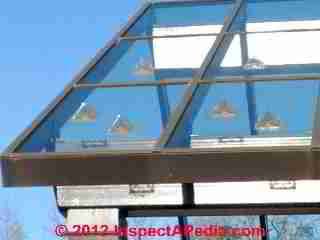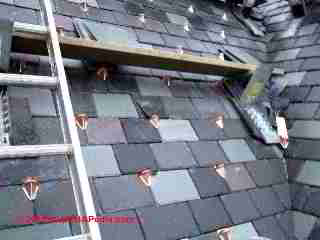 Snow Guard Mounting Methods
Snow Guard Mounting Methods
5 Snow retention system attachment methods
- POST a QUESTION or COMMENT about snow guards & snow retention systems on buildings
Snow guard mounting approaches: five approaches to mounting snow retention systems on roofs or using snow-retention coatings, brakes, clamps, and similar devices are described here.
Detailed procedures for clamping or gluing snow guards to roofs are in companion articles listed here as well.
InspectAPedia tolerates no conflicts of interest. We have no relationship with advertisers, products, or services discussed at this website.
- Daniel Friedman, Publisher/Editor/Author - See WHO ARE WE?
5 Snow Retention System or Snow Guard Installation Mounting Methods
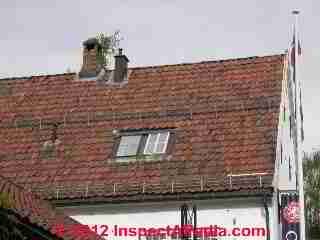 This article series illustrates types of snow guards or snow brakes or other snow retention devices used on metal, rubber, asphalt, and slate roofs and we explain and illustrate in photographs just how and where these devices are attached to building roofs.
This article series illustrates types of snow guards or snow brakes or other snow retention devices used on metal, rubber, asphalt, and slate roofs and we explain and illustrate in photographs just how and where these devices are attached to building roofs.
We give the reasons for snow & ice retainer use and their history.
Individual snow guard mounting methods vary depending on the roof covering material.
All snow retention systems use one of these methods to provide snow and ice retention for building roofs.
[Click to enlarge any image]
Our photo (left) illustrates structurally-mounted snow brakes or rails on a tile roof covering the Oslo Folk Museum.
As Norway experiences heavy snow fall, you will observe that the snow brakes are installed in two tiers and a close examination shows that the rail brackets are secured to the roof structure below.
- Structurally-connected snow retainer mounts: A snow retention device or its mounting bracket is fastened through the roof surface to the underlying roof sheathing or framing structure. For steel roofs the retainer mount may be welded to the roof surface.
For slate, tile, or shingle roofs, the leak risk of this approach can be minimal as the fasteners can be covered by subsequent courses of roofing material.
For metal roofs we prefer not to puncture the metal roof surface.
Structurally-connected snow & ice guard system mounts should be used where the loads (weight) of snow and ice are very great such as on large roofs or in deep-snow areas, or where the snow rail is itself large and heavy.
Watch out: depending on the total loads imposed by snow and ice on a roof, failures are still possible with structurally connected snow retainer systems if the screws, bolts, or their connection points are not adequately designed & installed on the roof.
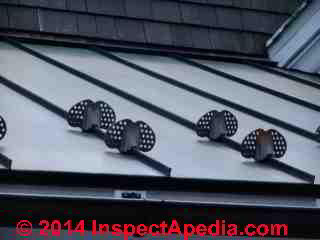
- Clamp-on snow retainer mounts: for standing seam metal roofs, various patented clamps secure to the raised rib portion of the standing seam and in turn provide a base for mounting snow shoes, snow guards, or snow rails or fences.
The clamp mounting method for mounting snow guards & fences is also quite strong and has the advantage of avoiding penetrations of the roof surface. Of course clamps mount on standing seams of metal roofs, not other roof surface shapes.
However the weight of snow and ice trying to slide down the roof - the load - is carried by the roof covering, and is transferred to the roof structure only by the metal roof mounting clamps beneath the roof surface.
Watch out: metal roof manufacturers warn that because snow guards mounted on the standing seam of a metal roof transfer load to the metal roof covering, good roof installation will be sure during roof installation to locate metal roof mounting clamps at a location and spacing to be sure that the metal roof is well-secured to the roof deck below areas where a snow retention system may be mounted.
Otherwise loads on the roof can bend or damage the metal roofing.
See SNOW GUARD CLAMP ON INSTALLATION
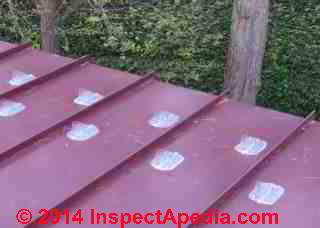
- Adhesive-bonded snow retainer mounts: a snow guard or supporting mount for a more extensive snow retainer system is glued to the surface of a metal, glass, or plastic roof surface.
Watch out: Most snow retention system failures occur with glued-on snow guards that were not properly bonded to the roof surface.
Depending on the care of installation and other factors, some contractors report having difficulty keeping glued mounts in place, observing them sliding down the roof before the glue has cured or dislodging from the roof surface entirely later-on.[5]
Note that most snow retention system product manufacturers warrant their system if it is installed according to their specifications.
The glue-on snow guard photos below show glued-on snow guards on a glass roof at a bank drive-through structure in Rhinebeck, NY in both summer (left) and winter (right).
Installing snow guards over walkways or as in this case drive-through openings can reduce the chances of falling snow-and-ice-related injury to passers-by.
However we also photographed this same roof on a subsequent winter during which the bottom course of glue-on snow guards were pushed off of the glass roof surface by heavy snow loads.

See SNOW GUARD GLUE ON INSTALLATION for a detailed procedure for gluing snow-guards to a glass or metal roof system.

- Clip-on Snow Retainer Systems: Atas and others offer clips that mount to the horizontal rail of a snow or ice retaining fence or rail, providing an additional degree of snow and ice retention on roofs.
On a metal roof one or at most two clips are mounted in the space between the standing seams. [5][6] - Snow-retention coating: for metal roofs, SnowGrip[10] offers a patented abrasive-based snow-retention coating for metal roofing.
The entire roof surface is coated with an abrasive material.
...
Continue reading at SNOW GUARDS on METAL ROOFS or select a topic from the closely-related articles below, or see the complete ARTICLE INDEX.
Or see these
Snow Guard & Snow Brake Articles
- METAL ROOFING
- ROOFING INSPECTION & REPAIR - roofing home page
- SLATE ROOF INSPECTION & REPAIR - home
- SLATE ROOF HARDWARE
- SNOW GUARDS & SNOW BRAKES
Suggested citation for this web page
SNOW GUARD MOUNTING METHODS at InspectApedia.com - online encyclopedia of building & environmental inspection, testing, diagnosis, repair, & problem prevention advice.
Or see this
INDEX to RELATED ARTICLES: ARTICLE INDEX to BUILDING ROOFING
Or use the SEARCH BOX found below to Ask a Question or Search InspectApedia
Ask a Question or Search InspectApedia
Try the search box just below, or if you prefer, post a question or comment in the Comments box below and we will respond promptly.
Search the InspectApedia website
Note: appearance of your Comment below may be delayed: if your comment contains an image, photograph, web link, or text that looks to the software as if it might be a web link, your posting will appear after it has been approved by a moderator. Apologies for the delay.
Only one image can be added per comment but you can post as many comments, and therefore images, as you like.
You will not receive a notification when a response to your question has been posted.
Please bookmark this page to make it easy for you to check back for our response.
IF above you see "Comment Form is loading comments..." then COMMENT BOX - countable.ca / bawkbox.com IS NOT WORKING.
In any case you are welcome to send an email directly to us at InspectApedia.com at editor@inspectApedia.com
We'll reply to you directly. Please help us help you by noting, in your email, the URL of the InspectApedia page where you wanted to comment.
Citations & References
In addition to any citations in the article above, a full list is available on request.
- [1] Berger Snow Retention Systems, Berger Building Products, 805 Pennsylvania Blvd.
Feasterville, PA 19053
Toll-free: 800-523-8852805,
Email: info@bergerbuildingproducts.com, Website: BergerBuildingProducts.com
See: http://www.bergerbuildingproducts.com/pdfs/catalog_snowguards.pdf - [2] Precision Snow-Guards, AceClamp®, Standing Seam Metal Roof Supplies, Precision Snow-guards™ - c/o PMC Industries, Inc. 87 Spring Lane, Plainville, CT 06062 Tel: (860) 229-SNOW (7669) provides clear or colored plastic snow guards for metal and rubber roofs, available in "King" and "Queen" sizes. Tel: (860) 229-SNOW (7669). Website: http://www.snow-guards.com/snowguards.php
- [3] S-5!® Snow Retention Systems, S-5! Attachment Solutions,
Metal Roof Innovations, LTD.
8655 Table Butte Road
Colorado Springs, CO 80908
(888) 825-3432, Email: info@s-5.com, Website: http://www.s-5.com/snow/
The company's products include milled solid block aluminum snow rail mounting clamps of varying shapes & designs. We are evaluating the S-5! clamps provided by this company. These clamps attach to the standing seams on a metal roof and in turn are used to attach a snow rail or snow fence. The company also provides solar panel hold-downs for metal roofs.- Ed. - [4] SnoBar™, Tel: 800-711-9724, Website: http://www.snobar.com/index.html The company's products include a patented one-piece roof clamp bracket & other brackets for attaching bars used as snow rails or snow fences. No street address was provided.
- [5] Alpine SnowGuards® 289 Harrel Street Morrisville, VT 05661 Tel: 888-766-9994, Email: info@alpinesnowguards.com Website: http://www.alpinesnowguards.com/ [No direct retail sales]
- [6] ATAS Snow Retention Products, ATAS Headquarters Allentown, Pennsylvania 18106 Phone: 800-468-1441 FAX: 610-395-9342 Email: info@atas.com, Website: http://www.atas.com/Company/Contact.aspx
- [7] Pacific Sheet Metal, Aspen Office & Shop, 401 Aspen Airport Business Center Aspen, Colorado 81611, Email: sales@pacificsheetmetal.net, Tel: 970.925.2454. The company provides a line of very sturdy snow rails or fences that mount to the seams of a metal roof.
- [8] Gough Snow Guards, Brookfield IL, Tel: 708-485-6272, Website: http://www.snoguard.com/ The company's products include copper snow guards installed on slate roofs and tile roofs, as well as standing seam metal roof snow retention systems.
- [9] AMSI Supply 4333 Lynwood Ct, Douglasville, GA 30134, metal roofing components, Tel: 800-943-9771
- [10] SnowGrip, 126 Woodward Ave., Iron Mountain, MI 49801, Tel: 06-396-7000, Email: mark@snowgripit.com Website: http://www.snowgripit.com/
- [15] Eric Galow, Galow Homes, Lagrangeville, NY. Mr. Galow can be reached by email: ericgalow@gmail.com or by telephone: 914-474-6613. Mr. Galow specializes in residential construction including both new homes and repairs, renovations, and additions.
- [17] "From Asbestos to Zinc, Gutters", Technical Preservation Services, National Park Service, U.S. Department of the Interior, web search 9./29.10, original source: http://www.nps.gov/history/hps/tps/roofingexhibit/gutters.htm
- [19] Asphalt Roofing Residential Manual from ARMA the Asphalt Roofing Manufacturers Association Website https://www.asphaltroofing.org/product/residential-asphalt-roofing-manual/ ,
- [20] Terry Anderson, "Snow Retention - the Invisible Code", web search 7/13/12, original source: http://snow.tra-mage.com/news-articles/snow-retention-the-invisible-code.html [copy on file as: Anderson Dec 2011 Interface.pdf ]
- Building Pathology, Deterioration, Diagnostics, and Intervention, Samuel Y. Harris, P.E., AIA, Esq., ISBN 0-471-33172-4, John Wiley & Sons, 2001 [General building science-DF] ISBN-10: 0471331724 ISBN-13: 978-0471331728
- Building Pathology: Principles and Practice, David Watt, Wiley-Blackwell; 2 edition (March 7, 2008) ISBN-10: 1405161035 ISBN-13: 978-1405161039
- Built-Up Roof Systems, Manual, C.W. Griffin, Mcgraw-Hill (Tx); 2nd edition (July 1982), ISBN-10: 0070247838, ISBN-13: 978-0070247833
- Concrete Folded Plate Roofs, C. Wilby PhD BSc CEng FICE FIStructE (Author), Butterworth-Heinemann, 1998, ISBN-10: 0340662662, ISBN-13: 978-0340662663
- Concrete Roofing Tile, History of the, Batsford, 1959, AISN B000HLLOUC (available used)
- Copper Roofing, by CDA
- Copper Roofing, Master specifications for copper roofing and sheet metal work in building construction: Institutional, commercial, industrial, I.E. Anderson, 1961 (hard to find)
- Corrugated Iron, Building on the Frontier, Simon Holloway
- Handbook of Building Crafts in Conservation, Jack Bower, Ed., Van Nostrand Reinhold Company, NY 1981 ISBN 0-442-2135-3 Library of Congress Catalog Card Nr. 81-50643.
- Historic Preservation Technology: A Primer, Robert A. Young, Wiley (March 21, 2008) ISBN-10: 0471788368 ISBN-13: 978-0471788362
- Historic Slate Roofs : With How-to Info and Specifications, Tina Skinner (Ed), Schiffer Publishing, 2008, ISBN-10: 0764330012 , ISBN-13: 978-0764330018
- Low Slope Roofing, Manual of, 4th Ed., C.W. Griffin, Richard Fricklas,
McGraw-Hill Professional; 4 edition, 2006, ISBN-10: 007145828X, ISBN-13: 978-0071458283
- Roof failure causes in depth (and specific methods for avoiding them)
- Roof design fundamentals and flourishes, based on voluminous industry research and experience
- New technologies and materials -- using them safely and correctly
- Comprehensive coverage of all major roofing systems pecifications, inspection, and maintenance tools for roofing work
- Metal Roofing, an Illustrated Guide, R.A. Knowlton , [metal shingle roofs],
- Problems in Roofing Design, B. Harrison McCampbell, Butterworth Heineman, 1991 ISBN 0-7506-9162-X (available used)
- Roofing The Right Way, Steven Bolt, McGraw-Hill Professional; 3rd Ed (1996), ISBN-10: 0070066507, ISBN-13: 978-0070066502
- Slate Roofs, National Slate Association, 1926, reprinted 1977 by Vermont Structural Slate Co., Inc., Fair Haven, VT 05743, 802-265-4933/34. (We recommend this book if you can find it. It has gone in and out of print on occasion.)
- Roof Tiling & Slating, a Practical Guide, Kevin Taylor, Crowood Press (2008), ISBN 978-1847970237,
- The Slate Roof Bible, Joseph Jenkins, www.jenkinsslate.com, 143 Forest Lane, PO Box 607, Grove City, PA 16127 - 866-641-7141 (We recommend this book).
- Tile Roofs of Alfred: A Clay Tradition in Alfred NY
- "Weather-Resistive Barriers [copy on file as /interiors/Weather_Resistant_Barriers_DOE.pdf ] - ", how to select and install housewrap and other types of weather resistive barriers, U.S. DOE
- Wood Shingle Roofs, Care and Maintenance of wood shingle and shake roofs, (EC), Stanley S. Niemiec (out of print)
- Our recommended books about building & mechanical systems design, inspection, problem diagnosis, and repair, and about indoor environment and IAQ testing, diagnosis, and cleanup are at the InspectAPedia Bookstore. Also see our Book Reviews - InspectAPedia.
- In addition to citations & references found in this article, see the research citations given at the end of the related articles found at our suggested
CONTINUE READING or RECOMMENDED ARTICLES.
- Carson, Dunlop & Associates Ltd., 120 Carlton Street Suite 407, Toronto ON M5A 4K2. Tel: (416) 964-9415 1-800-268-7070 Email: info@carsondunlop.com. Alan Carson is a past president of ASHI, the American Society of Home Inspectors.
Thanks to Alan Carson and Bob Dunlop, for permission for InspectAPedia to use text excerpts from The HOME REFERENCE BOOK - the Encyclopedia of Homes and to use illustrations from The ILLUSTRATED HOME .
Carson Dunlop Associates provides extensive home inspection education and report writing material. In gratitude we provide links to tsome Carson Dunlop Associates products and services.



